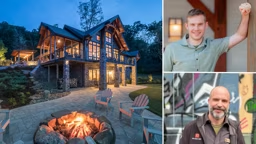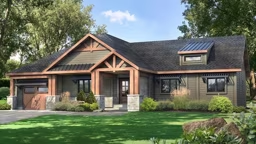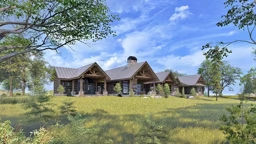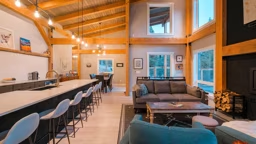
Aspen Leaf Interiors photo by Tom Zikas
Timber framing — or elements of it — are showing up in a variety of places, from popular furniture catalogs to car commercials. Finally, the general populace is catching on to something timber home craftsmen have known all along ... the warmth, permanence and history of heavy timber structures creates a sense of back-to-nature nostalgia that other types of housing, like stick-building or concrete, just can’t touch. To own one is a decision to reside in a work of art.
Yet timber framing still remains a small segment of the custom-home market, due, in part, to a lack of understanding of how to convey that this is the type of home a buyer is interested in building. Here, we will break down the basic options and teach you the essential terms so that you can discuss your wants and needs with confidence.
Know Your Options
Timber homes fall within one of several categories, based on how the timbers are used or are fastened, but all showcase the beauty of the wood, which adds character to a home’s interior.Traditional timber frames are fashioned by skilled artisans who carve the timbers’ interlocking wood joints by hand and fasten them with wood pegs (aka, trunnels) — never metal.
A post-and-beam home is similar to a timber frame, but its joinery is less complex, and its components are fastened with metal hardware, plates or rods.
Hybrid homes employ timber framing in some areas and alternative methods in others, or they may showcase purely decorative heavy wood trusses as part of the overall design, often as a way to help keep costs down.
Who’s Involved?
Before your home is complete, many people will have contributed to it. Here are just a few folks who will play a role in your quest for the perfect timber home:The most important decision you make will be the timber producer you choose to craft your frame. Once you start researching companies, you’ll discover that different outfits provide a wide variety of products and services. Some timber companies offer turnkey solutions, handling everything from design to building. Some will design and erect the frame itself, but don’t handle general construction. Others offer design and fabrication services only. Decide if you want to assemble and manage your own team or whether you would prefer to engage a company to take on these tasks for you.
With input from you, your designer or architect will create the plans for your home. Your designer might be on staff at a timber company, or you might choose an independent pro. Either way, the person drafting your home needs to work closely with your timber producer to make the framing and the layout cohesive.
Your general contractor’s job is to take your home from start to finish. He or she coordinates all the subcontractors who will work on the project, orders materials, meets with inspectors and keeps you apprised of the budget. During the construction process, the contractor will manage your job site, supervise all the specialty trades and much more. These workers may be on the general contractor’s staff, or they may be hired as subcontractors.
You can begin your search for many of these key people by looking at the ads found in Log and Timber Home Living magazine, attending a log and timber home show or by browsing our website. Always remember to ask potential team members for references. Go to a job site and visit a timber producer’s shop, if possible. Ask to see a designer’s completed homes and talk to the homeowners about the process. Above all, listen to your gut: You will work with each of these people for many months, so make sure your personalities and visions for the project mesh.
Specify Your Style
Whatever design motif you prefer for your dream home, you can find a timber frame that will set the tone. Pay attention to the photos in our magazine or on our website. You’ll discover that you favor some more than others, so note what you like about them. Follow up these initial leanings by consulting other books and timber producers’ web sites. You’ll begin to develop a direction for your home and its frame.From there, compile an idea folder online or clippings in a notebook. Save Pinterest boards and screen shots that demonstrate the layouts, styles, color palettes, finishes — even appliances — that appeal to you.
Patterns will start to emerge, and you can use that to drive your timber frame decisions. For instance, if you like the clean design of contemporary or modern styles, you might choose timbers that have clear grain, simple lines and very little carvings or ornamentation. If a dream home for you means a country or rustic style, look for a barn-style timber frame or one with hand-hewn timbers or round posts and beams. Old-World style might call for the handcrafted feel of carvings and timber embellishments. If the Arts & Crafts style moves you, you’ll find many timber producers who have fashioned homes in those styles from coast to coast.
Don’t have a clear favorite? A beautiful frame can be the unifying theme for an otherwise eclectic home that buzzes with visual interest.
See Also: Everything You Ever Wanted to Know About Timber Frame Homes











